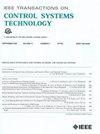New Fixed-Time Observer-Based Model-Free Fixed-Time Sliding Mode of Joint Angle Commanded NAO Humanoid Robot
IF 4.9
2区 计算机科学
Q1 AUTOMATION & CONTROL SYSTEMS
引用次数: 0
Abstract
In this article, we present a new fixed-time observer (FTO) with time delay estimation (TDE)-based model-free fixed-time sliding mode for the problem of robust walking of the NAO robot. The proposed technique ensures convergence in fixed time, regardless of initial conditions, thereby enhancing both convergence speed and robustness. This method allows for precise tracking of the joint angles’ positions without depending on the robot’s dynamic models while reducing the chattering via a modified exponential reaching law (MERL). To address the complexities of stabilizing the walking dynamics of the NAO robot, which include highly nonlinear dynamics and limited computational process, the proposed strategy utilizes the TDE technique for system model estimation. To mitigate estimation errors, a novel observer with guaranteed fixed-time stability is proposed. This last helps to enhance the tracking performance. Using the Lyapunov theory and experimental validation, within the proposed composite control method, the proposed nonsingular terminal sliding surface’s fixed-time stability along with the system state’s stability is verified. Significantly improved stability and accuracy in the robot’s joint movements are demonstrated through experimental results, validating the efficacy of the tracking trajectory for robotic systems such as the NAO humanoid robot.基于固定时间观测器的无模型NAO仿人机器人关节角固定时间滑模
针对NAO机器人的鲁棒行走问题,提出了一种新的基于时滞估计的无模型固定时间滑模固定时间观测器(FTO)。该方法在不考虑初始条件的情况下保证了固定时间内的收敛性,从而提高了收敛速度和鲁棒性。该方法可以在不依赖于机器人动力学模型的情况下精确跟踪关节角度的位置,同时通过改进的指数趋近律(MERL)减少抖振。针对NAO机器人行走动力学稳定的复杂性,包括高度非线性动力学和有限的计算量,提出了利用TDE技术进行系统模型估计的策略。为了减小估计误差,提出了一种具有保证定时稳定性的观测器。这有助于提高跟踪性能。利用李雅普诺夫理论和实验验证,在所提出的复合控制方法中,验证了所提出的非奇异末端滑动面的定时稳定性和系统状态的稳定性。实验结果表明,该方法显著提高了机器人关节运动的稳定性和准确性,验证了NAO类人机器人等机器人系统跟踪轨迹的有效性。
本文章由计算机程序翻译,如有差异,请以英文原文为准。
求助全文
约1分钟内获得全文
求助全文
来源期刊

IEEE Transactions on Control Systems Technology
工程技术-工程:电子与电气
CiteScore
10.70
自引率
2.10%
发文量
218
审稿时长
6.7 months
期刊介绍:
The IEEE Transactions on Control Systems Technology publishes high quality technical papers on technological advances in control engineering. The word technology is from the Greek technologia. The modern meaning is a scientific method to achieve a practical purpose. Control Systems Technology includes all aspects of control engineering needed to implement practical control systems, from analysis and design, through simulation and hardware. A primary purpose of the IEEE Transactions on Control Systems Technology is to have an archival publication which will bridge the gap between theory and practice. Papers are published in the IEEE Transactions on Control System Technology which disclose significant new knowledge, exploratory developments, or practical applications in all aspects of technology needed to implement control systems, from analysis and design through simulation, and hardware.
 求助内容:
求助内容: 应助结果提醒方式:
应助结果提醒方式:


